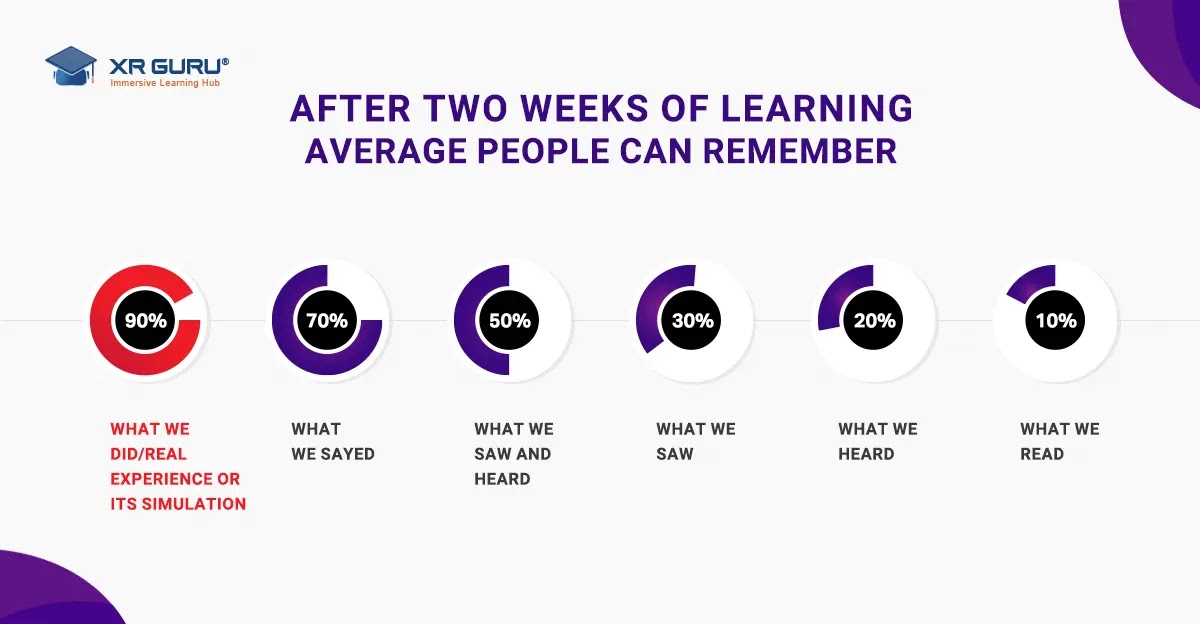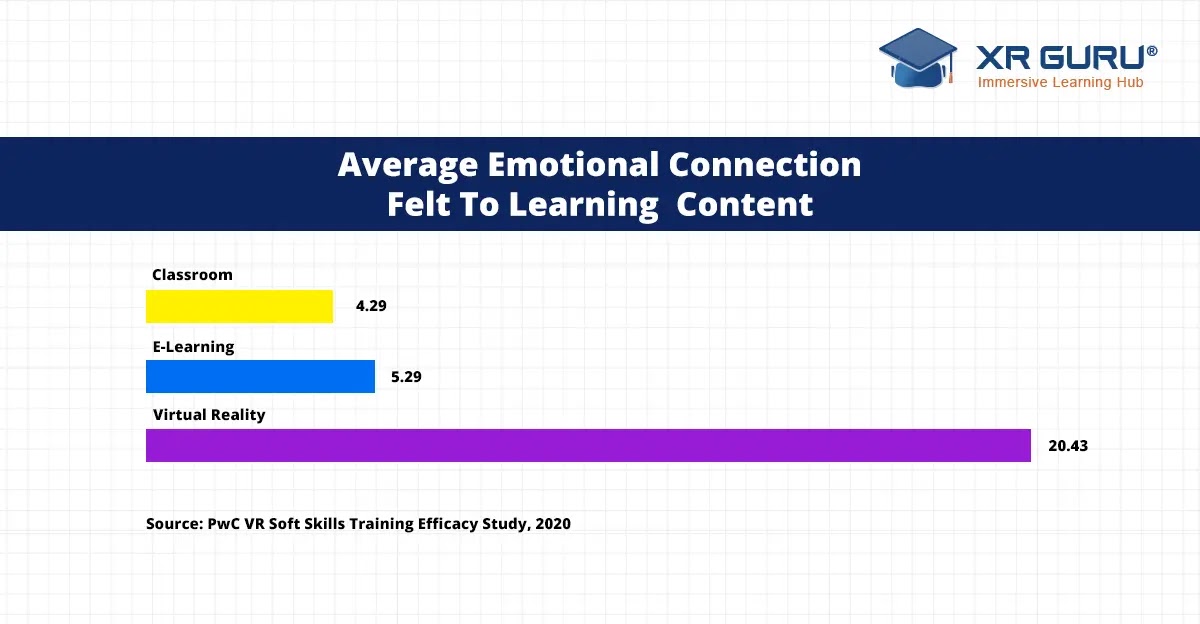
Do you want to learn more about using virtual reality for corporate training?
On 12 September 2022, 01:00 p.m. EST, XR Guru is conducting a webinar on "Virtual Reality Basic Skills Training." Join our webinar to hear from our experts and learn more about using VR in workforce training.
Here is an Overview of Our Blog:
1. What is Virtual Reality Training
2. Why Now is the Ideal Time for VR Training?
2.1. The Tech is Ready Now
2.2. Remote Working is the New Normal
2.3. Early Adopter Benefits
3. Virtual Reality Training Benefits
3.1. Time-Saving
3.2. Cost-Effective
3.3. Improves Knowledge Retention
3.4. Offers a Safe Training Environment
3.5. Increases Engagement
3.6. Better Analysis
4. Interesting VR Training Use Cases
4.1. Hilton
4.2. Military and Law Enforcement Training
4.3. Aviation Training
5. The Bottom Line
1. What is Virtual Reality Training
Virtual reality (VR) training is an immersive training experience that creates a life-like environment and simulates challenging tasks. It gives employees the opportunity to gain on-the-job training in a safe, low-risk, computer-generated environment where they can learn by doing. Knowledge retention in VR is very high, implying it is more likely to be applied in the workplace, thus increasing productivity.
2. Why Now is the Ideal Time for VR Training?
You may wonder, "why VR training and why now?" VR is becoming more mainstream by the day and making a real-world impact. Here are some reasons why you should adopt VR now:
2.1. The Tech is Ready Now
Immersive technology was once only appropriate for ultracomplex training activities such as flight simulations. However, VR has come a long way since and has become affordable for businesses of every shape and size. VR headsets that were once clunky and expensive are now sleekier and cheaper. Further, VR content creation and management platforms have made deploying VR-based training easier. This improves training outcomes, reduces adoption time, and makes VR applications more accessible.
2.2. Remote Working is the New Normal
Post the COVID-19 pandemic, working from home has become the new norm. In fact, a survey by the Chartered Institute of Management (CIM) found that 80% of firms in the UK now use a hybrid working model. Using VR for training eliminates geographical boundaries, making remote training possible. With VR, organizations can train employees from anywhere in the world.
2.3. Early Adopter Benefits
Companies worldwide are becoming more aware of the potential of virtual reality training and are already implementing VR-based training programs. Data shows that VR training is more effective. So, becoming an early adopter and reaping the benefits of VR can help you remain competitive.
3. Virtual Reality Training Benefits
Adopting a VR-based training approach offers several benefits, and some of them are as follows:
3.1. Time-Saving
The immersive nature of VR training helps people learn faster. VR simulations mirror the real-world environment, allowing trainees to master new skills quickly and remember information for a prolonged period. A study by PwC found that VR learners completed training four times faster than classroom training and 1.5 times faster than online training.
3.2. Cost-Effective
Unlike conventional training programs, VR training activities are scalable and can be repeated multiple times. Also, businesses can use virtual reality for remote training, eliminating travel costs. A study into the use of virtual reality for neonatal workers' training showed a 50% reduction in training costs over 3 years compared to traditional training programs. With the cost of VR equipment and VR software development costs projected to reduce in the future, VR is a cost-effective training option for businesses.
3.3. Improves Knowledge Retention
Learning with immersive 3D content and being fully immersed in a distraction-free environment helps trainees retain more information for longer. The knowledge retention level a year after a VR training session can be as high as 80% compared to 20% after a week with traditional training. Other studies show that retention rates are 75% for VR-based training compared to 5%-10% for conventional learning techniques.

3.4. Offers a Safe Training Environment
Organizing in-person and onsite training can be challenging, as dangerous training activities such as heavy machinery training can cause physical injuries. Fortunately, virtual reality offers a safe, computer-generated training environment where learners can practice their skills without worrying about real-life consequences. Additionally, learners can repeat the VR training activities as often as they like and learn from their mistakes. For instance, medical professionals can use VR simulations to practice surgery in a virtual environment and perfect their skills before operating on a real-life patient.
3.5. Increases Engagement
One of the significant disadvantages of traditional training is the lack of engagement. Often trainees find these conventional training programs boring and are easily distracted. The immersive and distraction-free environment presented by VR makes for an engaging experience and increases trainee engagement levels. A study found that VR learners are 3.75-times more emotionally connected to the learning content than classroom learners.

(Source)
3.6. Better Analysis
Virtual reality training programs offer several useful tools to monitor trainee behavior and evaluate the effectiveness of the training program. VR-based training captures real-time data and offers instant feedback to trainees to improve their performance. VR applications include key performance indicators (KPI) and biometric tools that help businesses assess trainees' ability to perform in a high-risk environment.
4. Interesting VR Training Use Cases
Several companies of different sizes are already using virtual reality solutions for corporate training. Here are some examples of successful adoption of virtual reality for training:
4.1. Hilton
Virtual reality training is being used by hotel chains. Hilton Worldwide Holdings Inc., a multinational hospitality company, uses virtual reality to train its employees. The company uses VR training to improve employees' soft skills, refine their work, and offer customers high-quality services.
4.2. Military and Law Enforcement Training
Militaries of some developed countries like the USA are taking advantage of VR-based training programs. The Virtual Squad Training System (VSTS) at Schofield Barracks in Hawaii uses VR simulations as a part of their military training. Given the high-risk nature of military service, soldiers have to be always ready and instantly react and adapt to any situation. Thus, practicing in a safe virtual environment and mastering the necessary skills will help them successfully complete real-life missions.
4.3. Aviation Training
The airline industry has been one of the quickest to embrace virtual reality technology. Airlines like Lufthansa are using VR technology to train flight attendants. Since 2019, Lufthansa has trained 20,000 flight attendants using VR. One of the biggest advantages of using VR is that there is no need to ground operations or create a full-size replica of an aircraft for training.
5. The Bottom Line
It has become a necessity for businesses to adopt cutting-edge technologies like VR to stay competitive in today's market. The employee training experience is crucial to improving productivity, engagement, development, and commercial success. Virtual reality training has been shown to reduce training time, save money, and improve training outcomes. With the cost of VR hardware and software development costs reducing by the day, it is safe to assume that VR will play a prominent role in the future of workplace learning.
Join Us for Our Next Webinar
Title: Virtual Reality Basic Skills Training
Improve Training Outcomes with Virtual Reality!
Do you want to enhance the employee training experience? If you are exploring different techniques to improve workforce training, learn how to use immersive virtual reality technology for workforce training and the advantages of virtual reality-based training programs.
Join our live webinar to learn more about using virtual reality technology for basic skills training.
If you cannot attend, register anyway, and we will send you the recording.
Host: Doug Smith
When and Where:
01:00 p.m. EST, Monday, September 12, 2022
25 Minutes
Zoom Link for Registration
Goal: To help businesses understand how to use virtual reality for corporate training and how it can help companies boost productivity and improve training outcomes.
Who Should Join:
- Business and Industry Heads
- Senior Management Professionals
- Corporate Board Members
- Entrepreneurs
- Those aspiring to adopt VR for workforce training
Highlights of the Webinar:
- Learn how to use virtual reality for employee training
- Learn how VR helps in workforce training
- Learn the benefits of using VR for corporate training
- View samples of immersive content
- Learn how to access our free Authoring Tool
- View samples of content you can create in our Authoring Tool
Outcome: Attending this webinar can help you understand how adopting virtual reality for corporate training can increase productivity and offer your employees a better training experience.